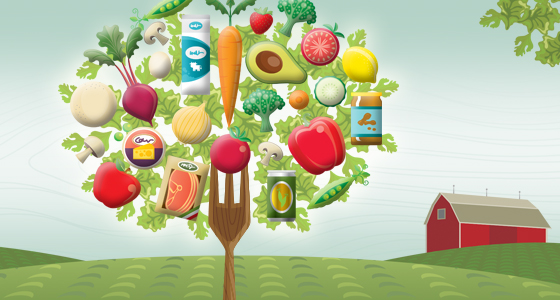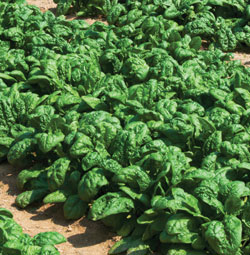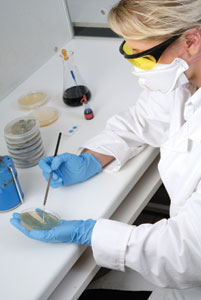Modernizing Food Safety from Farm to Fork
The Food Safety Modernization Act and proposed rules compel food industry stakeholders to be more proactive in ensuring food safety.

Earlier this year, the U.S. Food and Drug Administration (FDA) published two proposed rules for the Food Safety Modernization Act (FSMA) and held three public meetings for information and oral commentary (at press time, written comments due May 16, 2013). At the public meeting in Chicago, Ill., Polly Costello of Centennial, Wyo., described her family’s encounter with foodborne illness. Polly’s mother, Ruby, had been hospitalized for severe abdominal pain, dehydration, and other flu-like symptoms after eating a salad made with spinach contaminated with E. coli O157:H7; Ruby died within five days. Polly’s husband, Ken, also had experienced acute abdominal pain after eating the same batch of contaminated spinach but recovered after a week of extreme discomfort. The Costellos firmly believe that foodborne pathogens can “enter anywhere along the [food] supply chain from [farm] field to packing plant” and that certain safeguards may have prevented the misfortune they suffered. Their experience and concerns epitomize the main reasons for the FSMA and the proposed rules addressing produce safety and preventive controls for human food facilities: “We want people to eat more fresh fruits and vegetables; we don’t want them to be concerned about doing so,” says Michael Taylor, Deputy Commissioner, FDA Office of Foods and Veterinary Medicine. Both proposed rules emphasize the food industry’s primary role in ensuring safe food and preventing foodborne illness.
Produce Safety
The proposed rule on produce safety pertains to Title I– Improving Capacity to Prevent Food Safety Problems of the FSMA and establishes science-based standards for the growing, harvesting, packing, and holding of produce for human consumption. The produce safety rule applies to most domestic and imported vegetables, fruits, herbs, mushrooms, tree nuts, and sprouts in their raw or natural state. The rule does not apply to agricultural commodities that are rarely consumed raw, that are subjected to a pathogen-killing step (e.g., a robust thermal process), or that are grown for personal consumption, nor does it apply to grains. The rule also grants produce growers flexibility to use food safety practices that are appropriate for the size and nature of their agricultural operations. “The [FSMA] has mandated that we allow for variances. This allows for exemptions to all or part of the rule if certain criteria are met,” says Samir Assar, Director of Produce Safety Staff, FDA Center for Food Safety and Applied Nutrition (CFSAN). “[Produce growers] would need to show that practices under the variances … provide the same level of public health protection as the proposed rule without increasing the risk of adulteration.” Record keeping is required, but there is no requirement for a written food safety plan.
 Designed to minimize the risk of health consequences or death, the produce safety rule identifies and addresses the routes of microbial contamination of vegetables, fruits, and other produce. The principal agricultural components causing microbial contamination of produce are agricultural water; biological soil amendments of animal origin (e.g., composted manure); employee health and hygiene; animals living in the area; and equipment, tools, and buildings. The produce safety rule requires the inspection of agricultural water systems under a farm’s control at the beginning of the growing season, and the water must be safe for intended use. Because biological soil amendments of animal origin may contain pathogens, the rule proposes measures that address methods of application and time intervals between application and harvesting. Workers at produce-growing operations are required to engage in hygienic and health practices such as washing their hands, maintaining personal cleanliness, and discontinuing their contact with produce when they are ill.
Designed to minimize the risk of health consequences or death, the produce safety rule identifies and addresses the routes of microbial contamination of vegetables, fruits, and other produce. The principal agricultural components causing microbial contamination of produce are agricultural water; biological soil amendments of animal origin (e.g., composted manure); employee health and hygiene; animals living in the area; and equipment, tools, and buildings. The produce safety rule requires the inspection of agricultural water systems under a farm’s control at the beginning of the growing season, and the water must be safe for intended use. Because biological soil amendments of animal origin may contain pathogens, the rule proposes measures that address methods of application and time intervals between application and harvesting. Workers at produce-growing operations are required to engage in hygienic and health practices such as washing their hands, maintaining personal cleanliness, and discontinuing their contact with produce when they are ill.
Produce-growing operations that keep domesticated animals must make special efforts to keep animal feces away from the produce; this is also true for wild animals that may have access to crop fields. The produce safety rule’s requirements to achieve this include instituting a waiting period between animal grazing and harvesting produce near or around the grazing area and monitoring fields for the intrusion of wild animals immediately before harvest and throughout the growing season. The rule also sets standards for the inspection, sanitation, and maintenance of equipment, tools, and buildings of farming operations.
Produce growers that have annual sales of $25,000 or less do not have to comply with the produce safety rule, and certain other farms engaged in direct farm marketing are partially exempted from the rule. Despite these exemptions, which account for more than 100,000 farms, the FDA estimates the produce safety rule can prevent 1.75 million foodborne illnesses annually and save $1.04 billion in related costs for items such as medical care and lost productivity at work. Moreover, while some produce growers may be exempt from the produce safety rule, no entity is exempt from food safety. Taylor says that small growers are still ccountable for complying with the rules and regulations regarding the production and sale of safe food. The compliance date for the produce safety rule is 60 days after the final rule is published.
--- PAGE BREAK ---
Preventive Controls for Human Food Facilities
The proposed rule for preventive controls for human food facilities also pertains to Title I of the FSMA and has two main components. First, the rule applies to domestic and foreign facilities that manufacture, process, pack, or hold human food and requires their development and implementation of a written plan addressing hazard analysis and risk-based preventive controls. Second, the rule will revise the existing requirements of Current Good Manufacturing Practices (CGMPs). (Forthcoming proposed rules will address foreign supplier verification, accreditation of thirdparty auditors of foreign food facilities, and preventive controls for animal food.)
For the written plan, every facility registered with the FDA under the Food, Drug, and Cosmetic Act must identify and evaluate known or reasonably foreseeable unintentional hazards (i.e., a hazard analysis) for each type of food it manufactures, processes, packs, or holds. Such hazards could be biological, chemical, physical, or radiological, and a reanalysis of hazards should occur at least every three years. (The proposed rule for preventive controls is not intended for hazards that may be the result of deliberate adulteration. A separate rule will deal with that issue.) Secondly, the written plan must identify the preventive controls implemented to prevent or minimize known or foreseeable hazards. The preventive controls should include process controls, food allergen controls, sanitation controls, and a recall plan. Third, the written plan must identify monitoring practices to ensure that preventive controls are consistently applied. Records that document monitoring activities are also mandatory.
Next, the written plan must pinpoint corrective actions that will occur when preventive controls are improperly implemented. In addition to rectifying a problem, corrective actions must also minimize the prospect of recurrence, assess foods to determine whether they are safe for consumption, and prevent unsafe foods from entering the food supply. Verification of the consistent implementation of preventive controls is another requirement of the written plan. Not just anyone can develop the written food safety plan. The proposed rule requires that the written plan be prepared by an individual who has successfully completed special training or has job experience that qualifies him or her for the task. In addition to developing the plan, the qualified individual will validate the preventive controls, review records, and periodically reanalyze the plan.
 The second main feature of the proposed rule on preventive controls is that the FDA will amend the CGMPs for the manufacturing, packing, or holding of human food. The CGMPs will be revised to make clear that requirements for protection against contamination of food includes protection against cross-contact between food and allergenic ingredients such as eggs, soy, or tree nuts. The revision will entail the updating of some provisions and the deletion of others. The FDA is also considering whether appropriate training for food production employees should be required as well as records of such training.
The second main feature of the proposed rule on preventive controls is that the FDA will amend the CGMPs for the manufacturing, packing, or holding of human food. The CGMPs will be revised to make clear that requirements for protection against contamination of food includes protection against cross-contact between food and allergenic ingredients such as eggs, soy, or tree nuts. The revision will entail the updating of some provisions and the deletion of others. The FDA is also considering whether appropriate training for food production employees should be required as well as records of such training.
As with small farms and the produce safety rule, certain facilities are exempt from the preventive controls rule. Nevertheless, the revised CGMPs will be applicable to all human food facilities even if they are exempt from the requirements of conducting a hazard analysis and establishing risk-based preventive controls. Facilities that are exempt from hazard analysis and riskbased preventive controls include small businesses that engage in certain low-risk manufacturing, processing, packing, or holding activities on farms for specific foods; facilities that produce low-acid canned food (LACF) that is subject to the LACF regulation on microbiological hazards; grain elevators and warehouses that store raw agricultural commodities other than fruits and vegetables; and facilities that manufacture,
process, or pack foods that are covered by the regulations for Hazard Analysis and Critical Control Points (HACCP) (i.e., juice and seafood).
Applicable to all segments of the food industry, HACCP first embodied the philosophy that the safety of food requires the knowledge and understanding of hazards that are likely to occur in a particular food or at a food facility. Manufacturers, producers, and processors should have such information and apply it to their businesses. There are seven guiding principles to HACCP; the FDA’s rule for preventive controls parallels most of them: 1) conduct a hazard analysis, 2) determine the critical control points (CCPs), 3) establish critical limits, 4) establish a system to monitor control of CCPs, 5) establish the corrective action to be taken when monitoring indicates that a CCP is not under control, 6) establish procedures for verification to confirm that the HACCP system is working effectively, and 7) establish documentation concerning all procedures and records appropriate to HACCP principles and their application. The FDA’s rule for preventive controls does not require the setting of critical limits.
Because the rule for preventive controls for human food facilities is still in its proposal stage, there are several issues that the FDA has yet to determine and is therefore seeking commentary from food industry stakeholders. For example, the FDA is asking for input on questions such as the following: Should the FDA require personnel education and experience in the CGMPs instead of merely recommending them? Should the term “very small business” be defined as a business with annual sales of less than $250,000, less than $500,000, or less than $1 million? Should the FDA include potential hazards that may be intentionally introduced for economic reasons? Should a facility’s review of complaints—including those from consumers, customers, or other parties—be required as a way to verify that its preventive controls are effectively minimizing the occurrence of hazards? Should the FDA require finished product testing? Should environmental testing requirements be part of the final rule? Comments to these and other issues for both proposed rules—preventive controls and produce safety—are due May 16, 2013 (at press time).
--- PAGE BREAK ---
Concerns of Food Industry Stakeholders and Advocacy Groups
There are many aspects about the FSMA and the proposed rules that not only break new ground but also cause concern among food industry stakeholders. The law changes every aspect of the food system from farm to fork. For the first time ever, comprehensive, science-based preventive controls are mandatory across the food supply, and the FDA can review records of preventive controls and other components of food safety plans. Also a first, the FDA has the right to issue a mandatory recall when a company fails to recall unsafe food. Moreover, the FDA now has unprecedented authority to require that imported foods meet U.S. food safety standards and to deny the import of any food from a foreign facility or country that refuses to grant access to the agency (80% of seafood, 50% of fruits, and 20% of vegetables consumed in the United States are imported). And while some produce growers, processors, manufacturers, and operators of warehousing facilities think the proposed rules’ exemption categories are not broad enough, consumer advocacy groups believe, when it comes to food safety, there should be no exemptions at all.
Vanessa Coffman, Education Manager of STOP Foodborne Illness (www.stopfoodborneillness.org), questions the logic of excusing an illness or a death by claiming a food or facility was exempt from food safety rules. Foodborne pathogens can reside anywhere, she says; they do not distinguish between small and large produce-growing operations or processing facilities. Coffman also contends that exemptions for produce not normally consumed raw are senseless as the potential for contamination exists for these items as well. Cynthia Haskins, Manager of Business Development & Compliance at the Illinois Farm Bureau (www.ilfb.org), also questions the rationale for allowing exemptions for certain produce growers. She points out that some produce growers allow family pets to follow them around the crop fields, which elevates the risk of contaminated produce. “Just because produce is grown on a smaller scale does not guarantee it is safer,” she says. “Food safety is everyone’s responsibility regardless of the farm size.” Haskins is alarmed by the Centers for Disease Control and Prevention’s assertion that produce items are the source for 46% of foodborne illnesses. “That is a shocking statistic and one that needs our attention,” she says.
Tom Knibbs, President of Urban Accents in Chicago, Ill. (www.urbanaccents.com), says that his small custom-blend spices company is committed to food safety, but complying with the proposed rule on preventive controls will be costly. “For small and very small companies, the preventive controls will be difficult to implement in two years. A small or very small company may not be as well-versed in food safety requirements as a large company,” he says. Compliance with the FSMA’s requirements for a written food safety plan, periodic hazard analyses, record keeping, the hiring or training of a qualified individual, and foreign-supplier and product certifications must be complete within one to three years of publishing of the final rule on preventive controls, depending on the size of the business. “Large companies probably already have food scientists and other staff members who can serve as a qualified individual and do what the FDA is requiring. We all agree that food safety is important and take it very seriously, but for small and very small companies, these requirements are difficult to achieve. Four or five years to implement these requirements would be ideal,” he says. “Realistically, you can’t put a cost on safety, but my concern is that we receive enough time and training to meet the requirements.”
 Ernie Harben, Senior Manager, Safety and Regulatory Compliance, of Saddle Creek Logistics of Lakeland, Fla. (www.sclogistics.com), has different concerns. From Harben’s perspective, the requirements and rules of the FSMA may place operational restrictions on facilities that hold food. The proposed rule on preventive controls allows the exemption of warehousing facilities that engage solely in holding packaged food that is not exposed to the environment as long as the food does not require refrigeration. “We are concerned about the FDA’s interpretation of that rule, specifically whether the exemption applies to facilities that [hold] packaged foods but may also hold general retail consumer goods such as electronics, paper products, and other nonfood items,” Harben says. Financial costs are another concern: “Costs may be significant in some areas such as the hiring of a qualified individual. We have facilities in 29 locations [in 11 states] across the country, so we would have to hire individuals across the country for each facility. Costs for potentially hiring individuals to monitor temperature control and perform quality analysis of food would also be of concern,” Harben explains. “We pride ourselves on our standards and ability to keep food safe. However, we would definitely have to assess what’s necessary for us in order to continue to provide a high level of service to all our customers.” Peter Vardon, Senior Economist, FDA CFSAN, says that the FDA recognizes that financial costs are a significant issue for some companies, so certain facilities will have longer compliance periods than others.
Ernie Harben, Senior Manager, Safety and Regulatory Compliance, of Saddle Creek Logistics of Lakeland, Fla. (www.sclogistics.com), has different concerns. From Harben’s perspective, the requirements and rules of the FSMA may place operational restrictions on facilities that hold food. The proposed rule on preventive controls allows the exemption of warehousing facilities that engage solely in holding packaged food that is not exposed to the environment as long as the food does not require refrigeration. “We are concerned about the FDA’s interpretation of that rule, specifically whether the exemption applies to facilities that [hold] packaged foods but may also hold general retail consumer goods such as electronics, paper products, and other nonfood items,” Harben says. Financial costs are another concern: “Costs may be significant in some areas such as the hiring of a qualified individual. We have facilities in 29 locations [in 11 states] across the country, so we would have to hire individuals across the country for each facility. Costs for potentially hiring individuals to monitor temperature control and perform quality analysis of food would also be of concern,” Harben explains. “We pride ourselves on our standards and ability to keep food safe. However, we would definitely have to assess what’s necessary for us in order to continue to provide a high level of service to all our customers.” Peter Vardon, Senior Economist, FDA CFSAN, says that the FDA recognizes that financial costs are a significant issue for some companies, so certain facilities will have longer compliance periods than others.
--- PAGE BREAK ---
“We like the fact that the proposed rule [on produce safety] takes a risk-based approach. We were concerned that there was going to be a list of high-risk commodities identified in the rule, based on [past] outbreaks and recalls, and we’re very pleased to see that is not the approach the FDA took,” says David Gombas, Senior Vice President, Food Safety and Technology, of United Fresh Produce Association in Washington, D.C. (www.unitedfresh.org). However, the proposed rule for preventive controls affects companies that grow and minimally process fresh produce (i.e., mixed-type facilities). He questions the need and fairness of requiring mixed-type facilities to comply with both the produce safety rule and the preventive controls rule. Roxanne Junge, representing farmers’ markets in Glenview, Ill., has a similar complaint: She wonders whether produce growers who wash, cut, or pack raw vegetables and fruits may now have to register their “facility” and enact other controls to comply with the preventive controls rule. Donald Kraemer, Senior Advisor, FDA CFSAN, says that the applicable proposed rule is contingent on the treatment of the commodity as well as the commodity itself. For example, if a farmer does nothing other than grow and harvest produce, then his farm is subject to only the produce safety rule. On the other hand, if a facility engages in growing/harvesting one commodity and processes another, then the produce safety rule applies to the first commodity and the preventive controls rule applies to the latter commodity.
Change is difficult, and it is likely that many food industry stakeholders find some aspect of the new food safety law with which they disagree. However, foods that cause illness or death thwart consumerism, which is vital for the food industry. From the perspective of the U.S. Congress and the FDA, there are two approaches to food safety and foodborne illness: 1) helping victims after adverse events occur and 2) preventing adverse events from occurring. The implementation of the FSMA indicates that U.S. lawmakers have embraced the second approach, shifting U.S. policy on food safety from reactive to preemptive.
IFT Webcasts Cover Proposed Rules
The Institute of Food Technologists has developed two ondemand webcasts on the proposed rules. The webcast “Produce Safety Standards: FDA and Industry Expert Insights” provides detailed information about the proposed rule for produce safety and potential implications for produce growers. Presenters are Samir Assar, Director of Produce Safety Staff, FDA Center for Food Safety and Applied Nutrition (CFSAN); James Gorny, Senior Advisor, FDA CFSAN; and David Gombas, Senior Vice President, Food Safety and Technology, United Fresh Produce Association.
The webcast “Preventive Controls for Human Food: FDA and Industry Expert Insights” provides detailed information about the proposed rule for preventive controls for human food facilities and potential implications for manufacturers, processors, and packagers of human food and warehousing facilities. Presenters are Donald Kraemer, Senior Advisor, FDA CFSAN; Virginia N. Scott, Senior Advisor, FDA CFSAN; John Bode, Principal, John Bode LLC; and David Acheson, Partner, Leavitt Partners LLC.
Both webcasts are available at http://www.ift.org/knowledge-center/learn-online/on-demand-webcasts.aspx.
Toni Tarver
is Senior Writer/Editor for Food Technology magazine
([email protected]).
